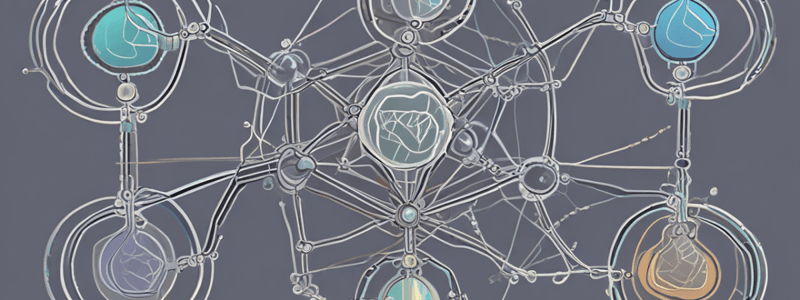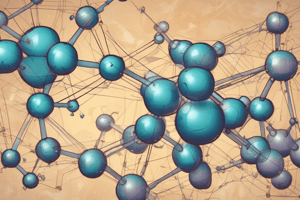Podcast
Questions and Answers
What is the main purpose of insertion and elimination in organometallic catalysis?
What is the main purpose of insertion and elimination in organometallic catalysis?
- To combine and transform ligands to expel them as useful products in a catalytic cycle (correct)
- To convert inorganic reagents into inorganic products
- To introduce a variety of 1e and 2e ligands into the coordination sphere of a metal
- To regenerate the metal species for subsequent reaction cycles
What is the product of a 1,1 insertion reaction?
What is the product of a 1,1 insertion reaction?
- M–AB–X, where AB is bonded to M only
- M–(AB)–X, where M and X end up on adjacent atoms of AB
- M–X–AB, where AB is bonded to M and X
- M–(AB)–X, where AB has formed a new bond with both M and X (correct)
What type of insertion is observed with CO as the ligand?
What type of insertion is observed with CO as the ligand?
- 1,1 insertion (correct)
- η2 insertion
- η1 insertion
- 1,2 insertion
What is the product of a 1,2 insertion reaction with ethylene as the ligand?
What is the product of a 1,2 insertion reaction with ethylene as the ligand?
What type of ligands typically undergo 1,1 insertion?
What type of ligands typically undergo 1,1 insertion?
What happens to the overall reaction rate if k−1 is very small relative to k2[L]?
What happens to the overall reaction rate if k−1 is very small relative to k2[L]?
What determines the type of insertion reaction that occurs?
What determines the type of insertion reaction that occurs?
What is the nature of the reaction kinetics if k−1 is very large relative to k2[L]?
What is the nature of the reaction kinetics if k−1 is very large relative to k2[L]?
What is the purpose of plotting l/kobs versus 1/[L]?
What is the purpose of plotting l/kobs versus 1/[L]?
What is the term often applied to the reactions involving intramolecular nucleophilic attack on A=B?
What is the term often applied to the reactions involving intramolecular nucleophilic attack on A=B?
What is the location of the labeled CO in the product when the incoming ligand is 13CO?
What is the location of the labeled CO in the product when the incoming ligand is 13CO?
What is the fate of the stereochemistry of the migrating group R in the intramolecular nucleophilic attack on A=B?
What is the fate of the stereochemistry of the migrating group R in the intramolecular nucleophilic attack on A=B?
What is the purpose of NMR and IR spectroscopy in this reaction?
What is the purpose of NMR and IR spectroscopy in this reaction?
What is kobs in the context of this reaction?
What is kobs in the context of this reaction?
What is the role of back donation in M–(A=B) bonding?
What is the role of back donation in M–(A=B) bonding?
What is the product of the reaction of CO insertion into metal–alkyl bonds?
What is the product of the reaction of CO insertion into metal–alkyl bonds?
What is the mechanism of the CO insertion into metal–alkyl bonds?
What is the mechanism of the CO insertion into metal–alkyl bonds?
What is the rate of the reaction of CO insertion into metal–alkyl bonds dependent on?
What is the rate of the reaction of CO insertion into metal–alkyl bonds dependent on?
What is the likely reason why the M–C bond in 7.8 is stronger than expected?
What is the likely reason why the M–C bond in 7.8 is stronger than expected?
What happens to the stereochemistry at both carbons in the usual syn insertion?
What happens to the stereochemistry at both carbons in the usual syn insertion?
What is the result of the rearrangement of the cis-vinyl complex to the trans isomer?
What is the result of the rearrangement of the cis-vinyl complex to the trans isomer?
What is the general principle that must be considered when interpreting reactivity trends?
What is the general principle that must be considered when interpreting reactivity trends?
What is the likely outcome of insertion with simple α-olefins?
What is the likely outcome of insertion with simple α-olefins?
What is the role of steric effects in the insertion of simple α-olefins?
What is the role of steric effects in the insertion of simple α-olefins?
What is a possible reason for M–alkyl bonds to be stronger than M–H bonds in f-block metals?
What is a possible reason for M–alkyl bonds to be stronger than M–H bonds in f-block metals?
What is the role of [Rh(OEP)]2 in radical photopolymerization of CH2=CHCOOR?
What is the role of [Rh(OEP)]2 in radical photopolymerization of CH2=CHCOOR?
What is the mechanism proposed for the reaction of butadiene with HMn(CO)5?
What is the mechanism proposed for the reaction of butadiene with HMn(CO)5?
What is the role of benzylic resonance in the insertion reaction?
What is the role of benzylic resonance in the insertion reaction?
What is the result of M–M bond homolysis of [Rh(OEP)]2?
What is the result of M–M bond homolysis of [Rh(OEP)]2?
What is the reactivity of butadiene with hydrides?
What is the reactivity of butadiene with hydrides?
Flashcards are hidden until you start studying
Study Notes
Insertion and Elimination
- Insertion and elimination reactions allow for the combination and transformation of ligands in the coordination sphere of a metal, ultimately leading to the formation of useful products.
- In insertion, a π-bound 2e ligand (A=B) inserts into an M–X bond to give M–(AB)–X, where AB has formed a new bond with both M and X.
Types of Insertion
- There are two main types of insertion: 1,1 and 1,2.
- In 1,1 insertion, M and X end up bound to the same atom of AB.
- In 1,2 insertion, M and X end up on adjacent atoms of AB.
- The type of insertion depends on the nature of A=B.
Factors Affecting Insertion
- η1 ligands give 1,1 insertion, and η2 ligands give 1,2 insertion.
- CO gives only 1,1 insertion, where both M and X end up bound to the CO carbon.
- Ethylene gives only 1,2 insertion, where the product has M and X on adjacent atoms of the ligand.
Kinetics of Insertion
- The rate of insertion depends on the magnitude of k−1 relative to k2[L].
- If k−1 is very small, the rate of the overall reaction is governed by k1, and we have a first-order reaction.
- If k−1 is very large, the rate of the overall reaction is governed by k2, and we have a second-order reaction.
- If k−1 is comparable to k2[L], the situation is more complicated, and the equation is usually rewritten as Eq. 7.11.
CO Insertion
- CO shows a strong tendency to insert into metal–alkyl bonds to give metal acyls.
- The usual mechanism of migratory insertion is shown in Eq. 7.7, where the alkyl group in the reagent undergoes a migration to the CO to give an acyl intermediate.
- The kinetics are reminiscent of dissociative substitution, except that the 2e site is formed at the metal in the migratory step, not by loss of a ligand.
Syn and Anti Insertion
- In the usual syn insertion, the stereochemistry at both carbons is retained.
- In some cases, apparent anti-insertion can occur, where the initially formed cis-vinyl complex rearranges to the sterically less hindered trans isomer.
Radical Pathways
- Radical pathways can also occur in insertion reactions, such as in the reaction of styrene with [Rh(OEP)]2.
- The reaction involves initial M–M bond homolysis to give a 15e metalloradical, which adds to the alkene to give a stabilized intermediate.
Studying That Suits You
Use AI to generate personalized quizzes and flashcards to suit your learning preferences.




